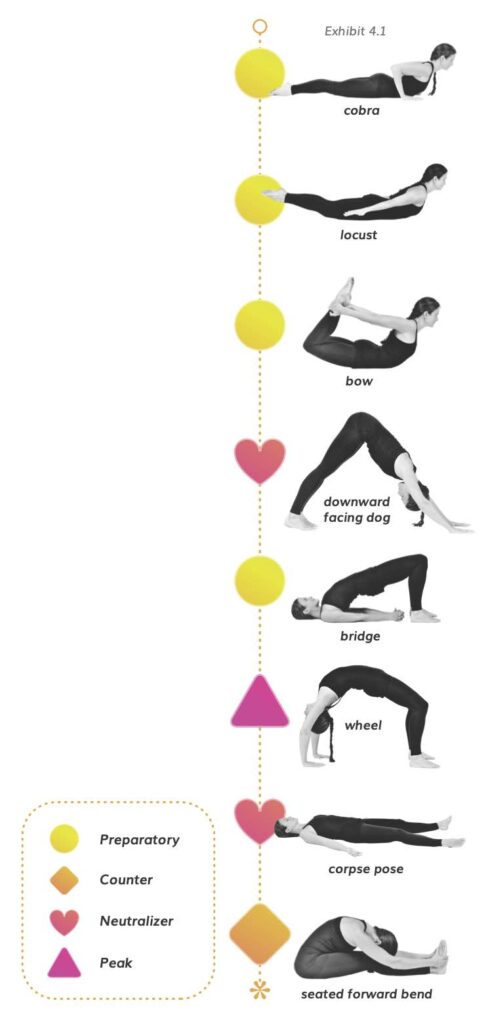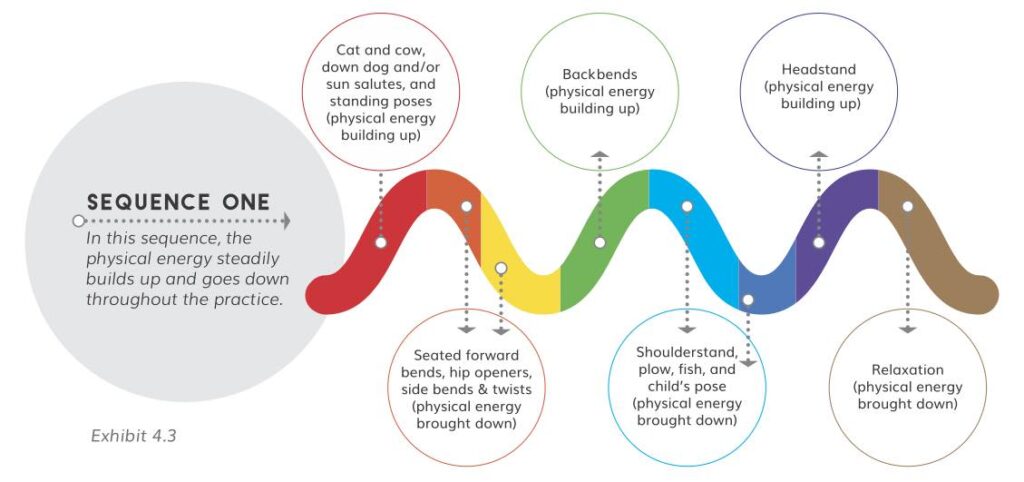Sequencing: Four Components
Four Key Components of Sequencing
Neutralizer Poses: The purpose of a neutralizer pose is to absorb and distribute life force energy through the body. In this way, we receive the maximum benefit of asana practice.
We typically practice neutralizer poses to transition from one posture category to another, to expend less energy, or to rest. For example, midway through practicing a series of backbends—moving from the least challenging to the most challenging asana—we pause and assume a pose in which the body is neutral. In this case, we relax our efforts for a “recharge” before moving into a more challenging backbend. Pose options might include lying flat on the back, twisting without countering the pose (see the next section for examples of counterposes), and similar neutralizers.
Any position in which the spine is neutral and the body is somewhat relaxed—putting forth less effort than in the previous pose—may be considered a neutralizer. In addition to twists, child’s pose with knees splayed wide and corpse pose are possible candidates. Choose neutralizing poses that flow with the sequence of the postures you select for your practice. Avoid choppy, repetitive instances of frequent standing up and then sitting/lying down; this allows the energetic flow to remain consistent.
Counterposes: A counterpose offers qualities and benefits that are the opposite of a pose previously practiced. For example, a forward bend is the counterpose for a backbend, and vice versa.
We also practice counterposes after completing a sequence of poses from a certain category of postures. Counterposes are practiced with the same (or with less) intensity as poses previously practiced from the opposite asana category.
Preparatory Poses: A preparatory pose is one that prepares or “preps” the practitioner for more challenging poses; “prep poses” build the necessary foundation. For example, downward-facing dog and dolphin are considered prep poses for the peak pose of headstand.
Peak Poses: A peak pose is one that the asana practice builds toward. Sequencing is designed to assist the yoga practitioner in preparing for a peak posture.
Asana Sequencing Example: Exhibit 4.1 is an example sequence that uses: neutralizer, counter, preparatory, and peak postures in a backbend group of asanas. This sequence moves from the least challenging to the most challenging backbend. Each pose assists in preparing for the next posture, leading up to the peak pose.

Asana Sequencing Examples
This section describes two general examples of an asana sequence, using the main posture categories I previously outlined. Keep in mind that these examples do not account for neutralizers, which may be used throughout each sequence.
Think of these sequences as a wavelength. We work within the distance between one peak (or crest of an energetic wave), and the next corresponding peak (or crest).
The Sequence One (Exhibit 4.3) example features a steady wavelength rhythm that first brings our physical energy upward (through poses that require more strength and/or create heat) and then brings the physical energy downward (through poses that cool and relax the body). This happens multiple times through the practice until the final relaxation.
The Sequence Two (Exhibit 4.4) example is a wavelength rhythm that steadily builds the physical energy upward to a primary peak and then works its way back downward. Both methods of sequencing are effective.
The actual poses within the practice may determine the route you take. For example, when you are focusing on maintaining arm-balancing poses—such as handstand, which requires upper body strength—you might choose the general outline for Sequence Two. Arm-balancing poses show up earlier in the practice of Sequence Two, when there is more physical energy to put into them. Alternately, you might choose the general outline of Sequence One because it provides your body with relaxing and cooling poses between the more physically demanding and heated poses.


These are just two of many possibilities for sequencing your asana practice. When creating a sequence, it is important to set an intention for arranging the poses in a certain way. The order of the poses is not random; a greater intelligence influences it. When we sequence our asana practice in an optimal way, our bodies, minds, and spirits find greater health, healing, and peace of mind.
Refer to Chapter 4, section on Sequencing in World Peace Yoga digital book for more information.
Teaching Asana: Questions for Self-Reflection in Connection to Sequencing:
- What does a typical asana class look like when you teach it? From start to finish.
- How do you begin? How do you end?
- How long do you spend going over any given posture?
- Whatever you do, have a good reason for doing it. Why are you teaching a particular pose? Why have you chosen the particular order of poses?
See sequencing
